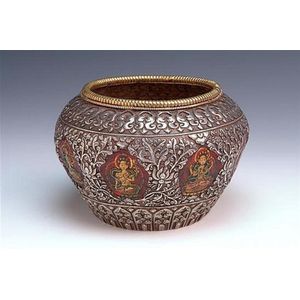Doulton Lambeth Gilded Cache Pot
You must be a subscriber, and be logged in to view price and dealer details.
Subscribe Now to view actual auction price for this item
When you subscribe, you have the option of setting the currency in which to display prices to $Au, $US, $NZ or Stg.
- Cache Pots - A cache pot, also spelt as cachepot, is a type of decorative container used to hold a flower pot containing a potted plant. The cache pot is a separate container from the plant's actual pot and is typically used to enhance the appearance of the plant or to hide an unattractive or functional flower pot. They are also used to protect the surface of furniture or floors from the water and soil of a potted plant. They can also be used to conceal an unsightly plastic nursery pot, or to provide a drainage layer for a plant.
Cache pots have been used throughout history to enhance the beauty of potted plants and were particularly popular during the Victorian era. Major manufacturers of ceramics cache pots included Minton, Wedgwood, Meissen and Royal Worcester. - Gilding - Gilding is a method of ornamentation whereby a thin sheet of gold metal is applied to items made of wood, leather, ceramics, glass and silver for decorative purposes.
For furniture including mirrors, the sheet of gold is usually applied over a coating of gesso. Gesso is a mixture of plaster of Paris and gypsum mixed with water and then applied to the carved wooden frames of mirrors and picture frames as a base for applying the gold leaf. After numerous coats of gesso have been applied, allowed to dry and then sanded a coat of "bole", a usually red coloured mixture of clay and glue is brushed on and allowed to dry, after which the gold leaf is applied. Over time parts of the gilding will rub off so the base colour can be seen. In water gilding, this was generally a blue colour, while in oil gilding, the under layer was often yellow. In Victorian times, gilders frequently used red as a pigment beneath the gold leaf.
Metal was often gilded by a process known as fire gilding. Gold mixed with mercury was applied and heated, causing the mercury to evaporate, the long-term effect of which was to kill or disable the craftsman or woman from mercury poisoning. The pursuit of beauty has claimed many victims, not the least of which were the artists who made those pieces so highly sought after today. - Circa - A Latin term meaning 'about', often used in the antique trade to give an approximate date for the piece, usually considered to be five years on either side of the circa year. Thus, circa 1900 means the piece was made about 1900, probably between 1895 and 1905. The expression is sometimes abbreviated to c.1900.
This item has been included into following indexes:
- cache pots - ceramic, various makers 17
- Royal Doulton (England), item types
-
Royal Doulton (England), special wares
- Silicon Ware 37
- Slater's patent 77
Visually similar items

Chinese porcelain ginger jar, probably made for the domestic market. Decorated with anemone above a fence border, without lid. Some expected signs of wear and use, minor chipping to inner foot. Height 15 cm

A silver holy water vessel, repousse floral motif, eight cartouches with diety figures, 8.8 x 12.5 cm

A Pilkington Royal Lancastrian 'leaf' decorated lustre vase, circa 1920, by William S Mycock, stamped Royal Lancastrian, England, 3184, monogrammed W. S. M, 16 cm high

A Pilkington Royal Lancastrian Co lustre vase, Heraldic design circa 1920, decorated by William S Mycock, 43 cm high
